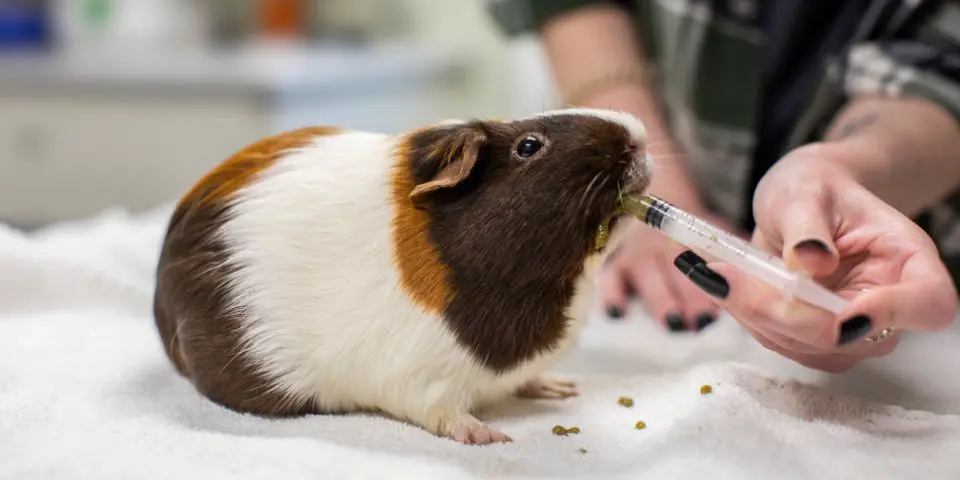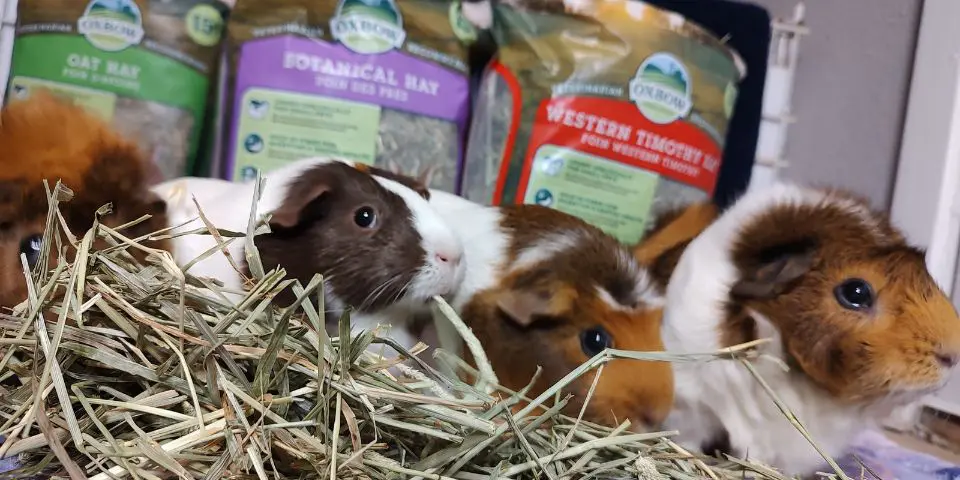Whether it’s your first experience with GI stasis or your hundredth, the onset of this painful, dangerous condition marks a scary occasion for any pet parent. What do you do if your small animal is experiencing GI stasis? Planning now, before stasis occurs, can help take the guesswork out of a highly stressful event where time is of the essence.
The Truth About Gastrointestinal Stasis
It’s Painful for Your Pet
Think back to some of the worst stomach pain or bloat you’ve ever had. Now think about what it would have been like if you couldn’t burp to relieve some of this gas. This is similar to what GI stasis might feel like for small herbivores. Stasis can in fact be so painful that your pet refuses to eat, creating a feedback loop of more pain, and more resistance to eating because of pain. In this way, stasis can be fatal if not proactively treated.
It Can Occur for More than One Reason
For older pets, especially, this is important to remember. For instance, when an older pet starts to feel some aches in their joints, it might result in a lower level of activity and foraging. If these low activity levels aren’t perceived by the pet parent, this can create a feedback loop as mentioned above, leading to more and more time your herbivore is spending not eating their all-important fiber because they’re feeling more and more uncomfortable.
 It’s Exhausting for Both of You
It’s Exhausting for Both of You
While you might not be the one experiencing the GI pain during a bout with stasis, it’s almost a guarantee that you’re going to be exhausted right along with your small herbivore. To make matters worse, stasis seems to rear its ugly head at the most inconvenient times—when you and your family are especially busy, and you feel like you’re running on fumes.
Some pet parents have found that having a “care package” for themselves, with quick-to-make foods, non-messy snacks, or other nutritionally dense foods helps them maintain their own sanity when there’s only enough time and patience to focus on your pet and not yourself.
Want to know more about what GI stasis really is and why it occurs? Check out our All About GI Stasis blog here!
8 Ways to Support Your Pet Before and During a Bout of GI Stasis
Gastrointestinal stasis is a serious and scary disease that creates stress for pet parents by putting your little loved one’s health in jeopardy. The good news is that there are some effective ways to support your pet before and during this difficult time. Support tips for gastrointestinal stasis include:
- Maintain a good support network during stasis emergencies.
- Learn your pet’s habits and behaviors.
- Keep Critical Care on hand.
- Feed your pet Critical Care before they get sick.
- Keep a variety of hays on hand.
- Feed hay in different ways.
- Keep a running list of your pet’s favorite fruits and veggies.
- Develop a good rapport with your exotics veterinarian.
1. Maintain a Good Support Network During Stasis Emergencies
In addition to being exhausting, fighting stasis can be isolating. It’s not a good time to leave the house, and your best efforts to care for your pet might be met with an apathetic “it’s only a small pet” by some in your orbit. Even if things turn out for the best, it’s essential to have supportive family and friends to help emotionally support you through this difficult time.
2. Learn Your Pet’s Habits and Behaviors
Knowing your pet’s particular quirks may help you spot stasis in its earlier stages. Small changes in daily habits, movements, and personality might signal an issue. In addition to learning about your pet as an individual, learning about your pet’s hard-wired instincts will also provide a wealth of knowledge in knowing what to watch for. Pet parents should watch for signs of hairballs and other obstructions. They should also know how to spot symptoms of bloat and gastrointestinal distress.
 3. Keep Critical Care on Hand
3. Keep Critical Care on Hand
While you can buy Critical Care through platforms like Amazon, we highly recommend purchasing Critical Care through your veterinarian. Veterinarian offices understand how to store products as important as Critical Care, and you’re more likely to receive a product that doesn’t expire in a few months, compared to when you roll the dice of ordering from a third-party seller online.
In the United States, there are 3 different types of Critical Care for Herbivores:
- Critical Care Anise is generally the go-to for many pet parents, but some find that their pets are not a fan of this flavor.
- Critical Care Apple Banana may be more palatable to some picky pets.
- And finally, Critical Care Fine Grind is papaya flavored. While Fine Grind is generally meant for specific uses such as tube feeding, the smaller particle size can create a smoother consistency that some pets may prefer.
Some pet parents keep all 3 types of Critical Care Herbivore on hand, as they’ve found that pets tend to refuse one flavor after a few feedings. Changing to a different flavor can make it easier to feed them in the early morning hours.
Note on Critical Care
This product is so versatile in how you can feed it! If your pet is refusing Critical Care and you’ve mixed it to a very thick consistency, try watering it down to make a “soupier” consistency. If your pet is refusing to eat Critical Care off of a spoon, you can offer it in a bowl for them to eat themselves, or you can try feeding via syringe. Whichever consistency and method you offer Critical Care, make sure you use warm water to mix, as cold water may cause more stomach upset.
Check out other great tips and tricks on how to feed Critical Care!
 4. Feed Your Pet Critical Care Before They Get Sick
4. Feed Your Pet Critical Care Before They Get Sick
Making sure that your pet thinks of Critical Care as a treat is going to make life so much easier when you and your pet both are pushed to the limit. If your pet associates the flavors and smells of Critical Care exclusively with memories of when they were previously sick and feeling their worst, they’re not going to willingly eat it. Once a month, consider mixing a tablespoon of Critical Care Herbivore for each small herbivore in the household in place of their regular treat.
 5. Keep a Variety of Hays on Hand
5. Keep a Variety of Hays on Hand
When your pet isn’t eating, sometimes you just need to throw everything at the wall and see what sticks. This can be especially important when it comes to offering a variety of grass hays to your pet.
Keep one bag of Botanical, Oat, and Alfalfa Hay on hand, as well as a package of Harvest Stacks with Chamomile and Harvest Stacks with Carrots. Adult herbivores are generally fed Western Timothy Hay or Orchard Grass, but when they’re refusing their normal hay, sometimes they may still be interested in the different aromas and flavor profiles that different hays offer.
Even if your pet is older, having alfalfa hay on hand can be very helpful; alfalfa has higher energy content and lots of protein. It’s best not to feed large quantities of alfalfa to adult herbivores routinely as it can increase the risk of obesity and urinary challenges (especially in rabbits and guinea pigs), but when they view it as a tasty snack, it can literally be a lifesaver.
 6. Feed Hay in a Different Way
6. Feed Hay in a Different Way
GI Stasis can sometimes be exacerbated if your pet’s hay container prevents them from easily accessing the forage. Hay feeders can be helpful when your pet is feeling 100% and requires mental stimulation. If your pet isn’t feeling well, however, enrichment that prevents easy access to their dietary staple can be detrimental.
If your pet is experiencing stasis or loose stools and you’re using enrichment that makes your pet work for their hay, remove the hay feeder and provide ample amounts of hay right on the ground. Let them spread it around, sit in it, and nest in it.
Sometimes it even helps to provide piles of hay near the openings of hideouts, or underneath open-bottom hideouts, so pets can eat hay but remain hidden. While not containing hay is messier to clean up, your pet may be more likely to eat on their own when hay is everywhere.
 7. Keep a Running List of Your Pet’s Favorite Fruits and Veggies
7. Keep a Running List of Your Pet’s Favorite Fruits and Veggies
Sometimes offering your pet’s favorite, species-appropriate fruits, veggies, and herbs can be enough to get food in their stomach and get them interested in hay again. While none of us dedicated pet parents want to think that we could forget about something our little one enjoys, it can happen as your pet ages and the chaos of everyday life continues. And, when you’re covered in globs of half-dried Critical Care and running off 4 hours of sleep, having a go-to list of your pet’s favorite produce will help.
Keep a reference list of your pet’s favorite produce on your phone (or any easily accessible location)—it may be crucial when you’re spread thin and running on “auto-pilot” at the grocery store. It’s also a good idea to keep track of any foods your kiddo particularly dislikes to avoid offering something that might further put them off food.
 8. Develop a Good Rapport with Your Exotics Veterinarian
8. Develop a Good Rapport with Your Exotics Veterinarian
It cannot be over-emphasized how much having a good, trusting, and professional relationship you’re your pets’ veterinarian helps when it comes to urgent needs. Developing a good rapport with an exotics vet during your pet’s regular check-ups is not only rewarding but paves the way to your vet understanding your pet’s health history, making it easier to treat your herbivore in urgent or critical situations.
Over time, your vet will develop an understanding of your habits as a pet parent, such as when you make appointments and why. Your own habits can be especially helpful when something as serious as GI stasis occurs. By showing your veterinarian that you are knowledgeable, watchful, and that you value their professional insight, they will more likely be able to tell when the situation is truly dire.
When It Comes to Stasis, One Size Doesn’t Fit All
While some of these tips are tried-and-true options for getting your pet through stasis, it’s likely that not all of these tips will help in your particular situation. Developing multiple contingency plans can seem like a lot, and can even bring up some unpleasant emotions, but is one of the best things you can do as a pet parent to a small herbivore. We wish you the best possible outcome for you and your little one.
